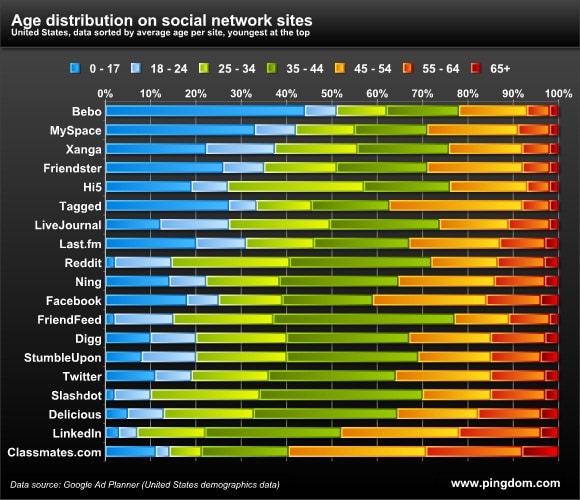When you plan to start a website, blog or service, it’s always good to know what audience you think your idea will appeal to. It will help you target your marketing campaign when it’s time to get the word out. Marketing is always tricky, and it can sometimes become one of the most vital parts of an online endeavor’s success. It’s pretty much customary today to take advantage of social media when you plan and execute your marketing campaign. If you don’t, you have pretty much neglected the most vital tool you could ever wield when trying to expose people to what you have to offer. But if you do, you of course need to know what the age distribution is on each of the social networking services you consider using for your marketing campaign.
Finding all that information for each social networking services is both time consuming and boring, so that’s why I decided to see if I could possibly find updated statistics for the most popular services to present to you. While searching, I came across a whole lot of interesting information about each and every service, but it feels like the age distribution of each service is more important than what features they have at their disposal, at least when you’re trying to target a certain age group with your product or service.
Statistics presented by Pingdom, which were acquired using Google Ad Planner, really have all the information we need. They are fresh statistics from 2012, and they could possibly point you in the right direction of what social networking platform would be the best to use for your marketing campaign. It’s a great tool to make sure your products gets in front of the eyes of the age group you are targeting.
For example, in this statistical chart, we clearly see that LinkedIn has a way older age distribution when compared to Facebook. I would say that is not too surprising. But when we look at Bebo, once a thought to be competitor to Facebook before AOL decided not to invest in further development of the service, has a much younger age distribution, which would speak in favor of a more active platform. Whether that is true or not (that it’s more active), I have no idea. Young people are usually more engaging and active on social media platforms than older people.
Whatever age distribution group you target, this statistical chart could definitely help you make an easier decision about which social networking platforms to use. These statistics are of course continuously updated, but they should not vary too much over short periods of time. Worth noticing though is that social networking platforms are always maintained and added to, so it’s important to keep a close eye on what new features are added or taken off in order to predict large changes in age distribution on any given social networking platform.
Pingdom’s Popular Social Platform Age Distribution
Via: [Central-E]

COMMENTS